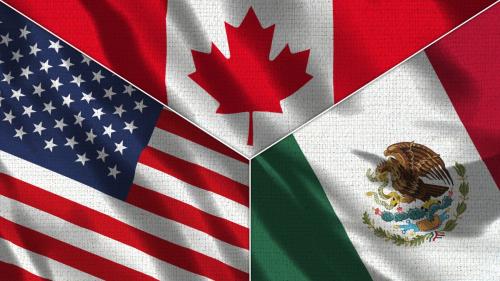This is a viewpoint from the USMCA Forward 2023 report where experts dive into the opportunities and complementary actions needed to build more integrated, resilient, and secure supply chains in North America.
 Manufacturers of all sizes, from small, family-owned and -operated businesses, to multinational enterprises, are counting on the United States–Mexico–Canada Agreement (USMCA) to strengthen their supply chains and help them grow. The USMCA can be a model for how the U.S., Mexico, and Canada can capitalize on our close regional ties, but it will require all three governments to live up to and uphold the spirit of the agreement. The rewards are worth it—if the USMCA works as intended, it can help address bigger geopolitical challenges and strengthen our supply chain resiliency.
Manufacturers of all sizes, from small, family-owned and -operated businesses, to multinational enterprises, are counting on the United States–Mexico–Canada Agreement (USMCA) to strengthen their supply chains and help them grow. The USMCA can be a model for how the U.S., Mexico, and Canada can capitalize on our close regional ties, but it will require all three governments to live up to and uphold the spirit of the agreement. The rewards are worth it—if the USMCA works as intended, it can help address bigger geopolitical challenges and strengthen our supply chain resiliency.
This summer will mark the third year since the USMCA was ratified. Free trade between our markets has been advantageous for manufacturers across the U.S. and North America for decades, and the USMCA helps to secure those advantages. The USMCA updated the standards for the 21st century digital economy and top-class intellectual property rules—which are absolutely essential for innovation. It ensured duty-free exports across our markets and broadened manufacturers’ access within the three North American countries in markets for products such as food and remanufactured goods.
Under these conditions, more than $2 billion worth of manufactured goods cross the U.S., Mexican, and Canadian borders each day. More than two million U.S. manufacturing jobs depend on the exports our industry sends to Mexico and Canada. Our business partners in these countries purchase one-fifth of the value of U.S. manufacturing output.
But the U.S. can and should do more to ensure that our partners live up to the spirit and letter of the USMCA. Major free trade agreements are only as good as their enforcement, and while the USMCA has valuable enforcement mechanisms, it is vital that we utilize these enforcement tools. For example, Mexico has taken up measures that create new regulatory hurdles and other commercial challenges that negatively impact market access for manufacturers in the U.S. Mexico’s energy generation and power policies are often preferential toward Mexican businesses, making it more difficult for manufacturers in the U.S. to do business in the market. These manufacturers have also faced holdups in the issuance of operating and customs permits for energy projects, limits on advertising and IP, and bans and new customs barriers that especially harm small businesses.
Other challenges impacting manufacturers in Mexico include expanded food-labeling requirements that threaten U.S. exports, the failure of Mexico’s regulators to promote competition in the telecom market, measures that would require excessively burdensome electronic waybills, a ban on imports of crop-protection products and biotechnology-derived agricultural products, and efforts to introduce new, problematic technical regulations and compliance requirements.
The Canadian government has also taken actions that undermine the spirit of the agreement. There is a Canadian government proposal to brand “plastic manufactured items” as “toxic substances” under the Canadian Environmental Protection Act, with direct implications for U.S. exports in a wide range of manufacturing sectors. And although Canada committed to opening its market for dairy producers under the USMCA, it has skirted these obligations through the manipulation of import license procedures and tariff-rate quota allocations that undermine access to the Canadian market.
Addressing these disruptive actions is essential to securing the long-term success of the agreement.
Our governments can also boost the effectiveness of the USMCA by strengthening the underlying fundamentals of our economies— especially our workforce. Manufacturers in the U.S. are facing a significant skills gap and will need to fill more than four million jobs by 2030, according to research by Deloitte and the Manufacturing Institute—the workforce development and education partner of my association, the National Association of Manufacturers. That means we should invest in training the skilled workforce we need. Our countries should also invest more in domestic production of key inputs, as the U.S. did with the CHIPS and Science Act last year to heavily boost U.S. production of semiconductors, providing a boon for the entire North American economy. And our countries should continue making historic investments in our critical infrastructure—which helps us move our goods and inputs across our markets—as the U.S. did with the Infrastructure Investment and Jobs Act in 2021.
These kinds of policies will position us well for continued global leadership and for economic competition with China. The connection between the USMCA countries should make it easier for us to coordinate our use of domestic and multilateral trade enforcement tools to target and counter problematic Chinese trade behaviors. As we continue to grow our own manufacturing capacity, we can build more resilient North American supply chains and source vital inputs to each other without depending on China for essentials, such as critical minerals. The U.S., for example, has more critical mineral reserves than any other country, and this should help bolster our supply chains across the continent without being subject to supply shocks in Asia.
The USMCA is an essential part of the foundation not only for the next manufacturing decade in North America, but also for our countries to strengthen our global competitiveness and economic influence. If our partners address these concerns—and they certainly can do so swiftly—then we will have even more to celebrate when that third anniversary rolls around.
The Brookings Institution is committed to quality, independence, and impact.
We are supported by a diverse array of funders. In line with our values and policies, each Brookings publication represents the sole views of its author(s).







Commentary
USMCA positions North America for global competitiveness
Tuesday, February 28, 2023